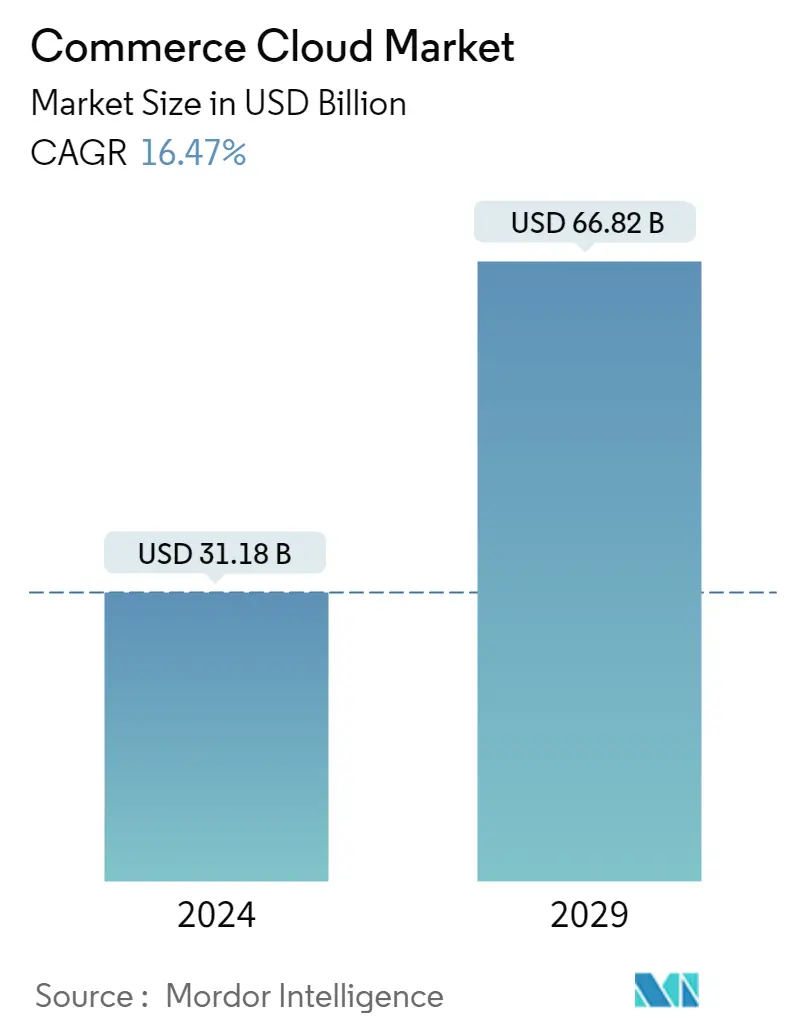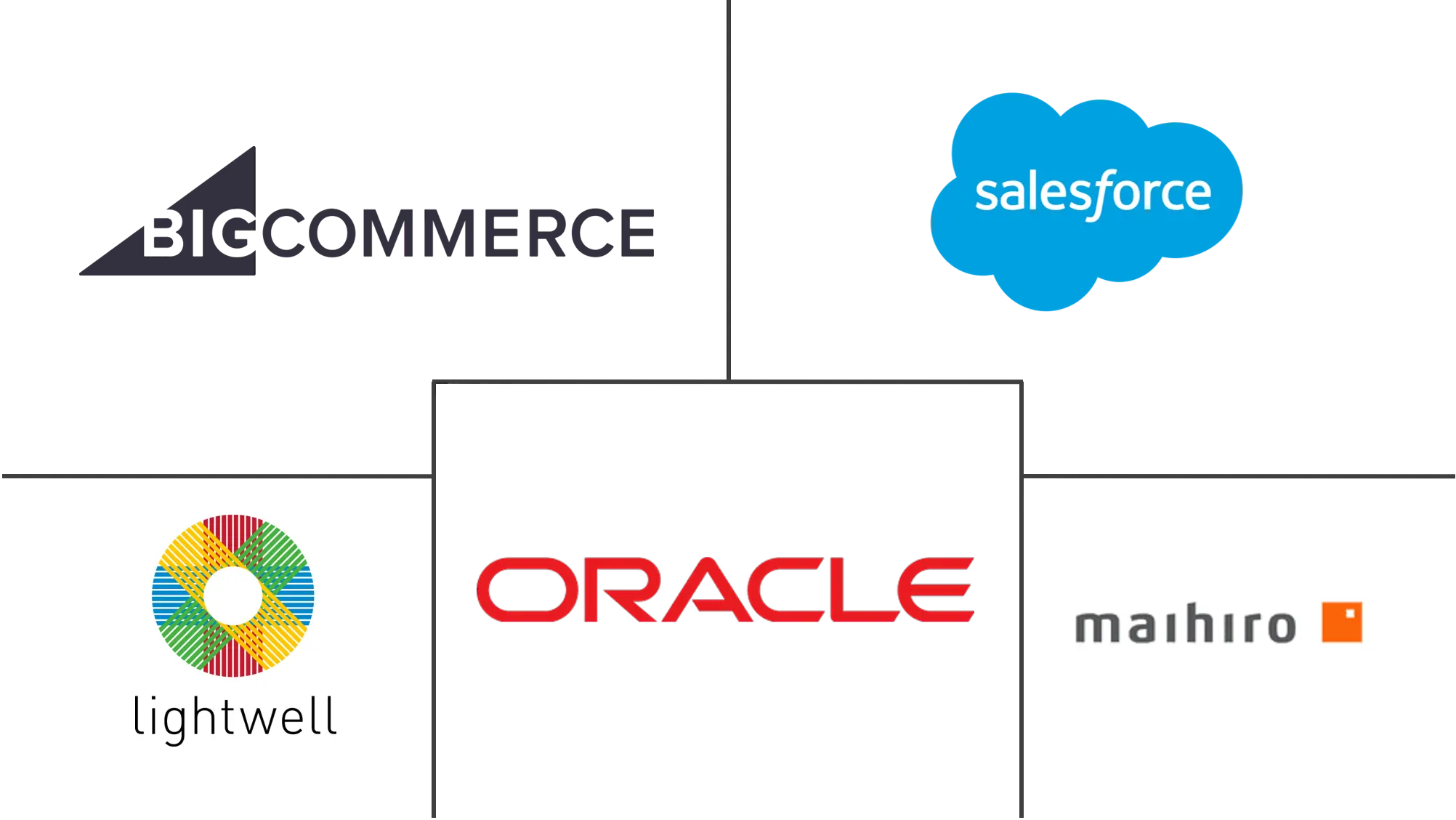Market Size of Commerce Cloud Industry

| Study Period | 2019 - 2029 |
| Market Size (2024) | USD 31.18 Billion |
| Market Size (2029) | USD 66.82 Billion |
| CAGR (2024 - 2029) | 16.47 % |
| Fastest Growing Market | Asia-Pacific |
| Largest Market | North America |
Major Players
*Disclaimer: Major Players sorted in no particular order |
Commerce Cloud Market Analysis
The Commerce Cloud Market size is estimated at USD 31.18 billion in 2024, and is expected to reach USD 66.82 billion by 2029, growing at a CAGR of 16.47% during the forecast period (2024-2029).
The massive growth of the e-commerce industry, coupled with the significant adoption of cloud computing solutions across industries, is expected to act as a major driver for the growth in the adoption of Commerce Cloud globally.
- Due to its minimal latency and networking virtualization capabilities, 5G is expected to facilitate secure and automated payment methods, which would boost the adoption and usage of cloud applications like mobile payments, smart wallets, and other digital banking services that are anticipated to use 5G for a quick and safer banking experience. Thus, the aforementioned reasons imply that 5G wireless networks would boost the adoption of cloud commerce systems.
- Also, an increasing focus on improving customer experience in the industry is expected to drive the market's growth. Technological advancements are raising customers' expectations and reshaping how they experience different brands. Companies that take a holistic CX (Customer Experience) approach by investing in technologies that will digitally transform the business to stay ahead of customer expectations see a 92% customer retention rate.
- However, privacy and security issues such as data security and network security, among others, are expected to hinder the adoption of Commerce Cloud solutions, especially amongst small and medium-sized businesses.
- Moreover, during the COVID-19 pandemic, the business landscape changed drastically, with a significant increase in the demand for digital business platforms. Hence, Salesforce Commerce Cloud released four quick-start pandemic business packages specifically designed to help conduct business during COVID-19.
- Furthermore, companies require the flexibility of multiple clouds. However, they continue to struggle with the complexity, operational silos, and costs of managing private and public clouds. Businesses require a unified solution that provides a consistent experience, tooling, and operational practices across clouds. Due to this, companies are focusing on enhancing their existing solutions.
- In October 2022, HCL Technologies, a global technology company, and Google Cloud announced the substantial expansion of their long-standing collaboration, with additional capabilities and service solutions to accelerate business migration to Google Cloud.
Commerce Cloud Industry Segmentation
Commerce Cloud solutions allow retail businesses to design, deploy, and manage their e-commerce capabilities. It enables customers to derive seamless omnichannel experiences and fulfill their evolving customer expectations. Cloud adoption across industries is influencing retailers to procure and deploy their IT assets due to the cloud's several benefits. Moving to the cloud allows for increased capacity utilization as well as the financial benefits of shifting capital expenditure to operating expenditure, resulting in a lower total cost of ownership.
Commerce Cloud Market is Segmented by End-user Industry (Fashion & Apparel, Pharmaceutical & Grocery, Electronics & Appliances, Travel & Tourism), Platform (B2B Commerce, B2C Commerce), Offering (Private Cloud, Public Cloud, Hybrid Cloud), and Geography (North America, Europe, Asia-Pacific, Latin America, and Middle-East & Africa).
The market sizes and forecasts are provided in terms of value (USD million) for all the above segments.
| By End-user Industry | |
| Fashion & Apparel | |
| Pharmaceutical & Grocery | |
| Electronics & Appliances | |
| Food & Beverage | |
| Other End-user Industry (Beauty & Personal Care, Travel & Tourism) |
| By Platform | |
| B2B Commerce | |
| B2C Commerce |
| By Offering | |
| Private Cloud | |
| Public Cloud | |
| Hybrid Cloud |
| Geography | |
| North America | |
| Europe | |
| Asia-Pacific | |
| Latin America | |
| Middle-East & Africa |
Commerce Cloud Market Size Summary
The Commerce Cloud market is poised for significant expansion, driven by the burgeoning e-commerce sector and the widespread adoption of cloud computing solutions across various industries. The integration of 5G technology is expected to enhance the adoption of cloud-based applications, such as mobile payments and digital banking services, by providing secure and automated payment methods. This technological advancement, coupled with a growing emphasis on improving customer experience, is reshaping brand interactions and driving market growth. Companies that invest in digital transformation to meet evolving customer expectations are seeing high retention rates. However, challenges such as data privacy and security concerns, particularly among small and medium-sized enterprises, may impede the widespread adoption of Commerce Cloud solutions.
North America is anticipated to lead the global Commerce Cloud market, supported by major players like IBM, Salesforce, SAP, and Oracle, who are making substantial investments in innovation and regional growth. The region's digitization efforts have opened new markets, offering businesses innovative ways to reach consumers. Collaborations between retailers and B2C commerce cloud providers are creating unified digital commerce experiences, as seen in partnerships like Salesforce and TikTok. The competitive landscape is moderately fragmented, with major players and emerging companies focusing on strategic partnerships and solution innovation to capture market share. Recent developments, such as Oracle's new B2B Commerce services and Emplifi's Social Commerce Cloud integration, highlight the ongoing efforts to streamline transactions and enhance customer engagement across digital platforms.
Commerce Cloud Market Size - Table of Contents
-
1. MARKET DYNAMICS
-
1.1 Market Overview
-
1.2 Market Drivers
-
1.2.1 Increasing Focus on Improving Customer Experience
-
1.2.2 Massive Growth of E-commerce Across Various Industries
-
-
1.3 Market Restraints
-
1.3.1 Privacy and Security Concerns
-
-
1.4 Industry Attractiveness - Porter's Five Forces Analysis
-
1.4.1 Bargaining Power of Suppliers
-
1.4.2 Bargaining Power of Buyers/Consumers
-
1.4.3 Threat of New Entrants
-
1.4.4 Threat of Substitute Products
-
1.4.5 Intensity of Competitive Rivalry
-
-
1.5 Assessment of Impact of COVID-19 on the Market
-
-
2. MARKET SEGMENTATION
-
2.1 By End-user Industry
-
2.1.1 Fashion & Apparel
-
2.1.2 Pharmaceutical & Grocery
-
2.1.3 Electronics & Appliances
-
2.1.4 Food & Beverage
-
2.1.5 Other End-user Industry (Beauty & Personal Care, Travel & Tourism)
-
-
2.2 By Platform
-
2.2.1 B2B Commerce
-
2.2.2 B2C Commerce
-
-
2.3 By Offering
-
2.3.1 Private Cloud
-
2.3.2 Public Cloud
-
2.3.3 Hybrid Cloud
-
-
2.4 Geography
-
2.4.1 North America
-
2.4.2 Europe
-
2.4.3 Asia-Pacific
-
2.4.4 Latin America
-
2.4.5 Middle-East & Africa
-
-
Commerce Cloud Market Size FAQs
How big is the Commerce Cloud Market?
The Commerce Cloud Market size is expected to reach USD 31.18 billion in 2024 and grow at a CAGR of 16.47% to reach USD 66.82 billion by 2029.
What is the current Commerce Cloud Market size?
In 2024, the Commerce Cloud Market size is expected to reach USD 31.18 billion.

